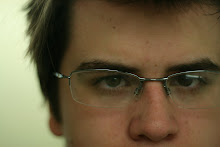









Light; when one searches www.dictionary.com for a definition, they are immediately given thirty nine definitions in which to choose from. The first definition is that light is something that makes things visible or affords illumination (www.dictionary.com). Yes, light does both those things, but is is also very fun to play with, especially with long exposure shots. There are two ways one can capture light with a camera, it works better if you have an SLR or a DSLR, but some point and shoots give you the option to change the shutter speed. You are also going to need a tripod or something to rest the camera on to make sure that the camera does not move. Next, choose your location. Here are a couple of suggestions for locations, though you can really go anywhere you want. First, someplace with cars, because the camera will capture the light of the headlights and the movement will create a light blur. Personally, I think this ends up looking wicked cool, especially if you do it at night and there are a lot of cars (like a freeway or a busy street). You can set the exposure for as long as you want to, just make sure it is more than a second to fully get those light trails! If you are feeling a little experimental (or arsty, I think those terms mean the same thing), you can try moving the camera a little or zooming in and out to create some interesting effects. Just experiment until you find something you like.
Now the above was just plain old long exposure photography, the next thing I will mention adds a little twist. Shoot the flash during a long exposure. Yes, you heard me correctly, I said shoot the flash, it won't ruin the picture I swear. Shooting the flash during a long exposure can create some interesting effects, such as freezing the subject of the photo but still causing some light blur around the subject. Now, you can either set the flash to be first stage or second stage (the flash firing once or the flash firing once). However, since it differs from camera to camera, I can't really tell how to turn on 1st and 2nd stage flash, you'll have to find out yourself. When it comes to long exposure photography, this is one of my favorite techniques because it really allows you to play with light. There are many subjects to use this technique with, such as bands or people moving around in a city. What you photograph is really up to you. Now the photos above are a combination of the two types. I hope you enjoy them and give me some constructive criticism.
Now the above was just plain old long exposure photography, the next thing I will mention adds a little twist. Shoot the flash during a long exposure. Yes, you heard me correctly, I said shoot the flash, it won't ruin the picture I swear. Shooting the flash during a long exposure can create some interesting effects, such as freezing the subject of the photo but still causing some light blur around the subject. Now, you can either set the flash to be first stage or second stage (the flash firing once or the flash firing once). However, since it differs from camera to camera, I can't really tell how to turn on 1st and 2nd stage flash, you'll have to find out yourself. When it comes to long exposure photography, this is one of my favorite techniques because it really allows you to play with light. There are many subjects to use this technique with, such as bands or people moving around in a city. What you photograph is really up to you. Now the photos above are a combination of the two types. I hope you enjoy them and give me some constructive criticism.





























